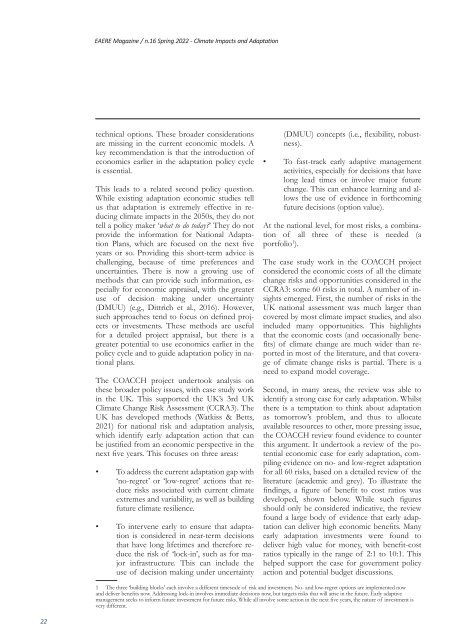EAERE Magazine - N.16 Spring 2022__
You also want an ePaper? Increase the reach of your titles
YUMPU automatically turns print PDFs into web optimized ePapers that Google loves.
<strong>EAERE</strong> <strong>Magazine</strong> / n.16 <strong>Spring</strong> <strong>2022</strong> - Climate Impacts and Adaptation<br />
technical options. These broader considerations<br />
are missing in the current economic models. A<br />
key recommendation is that the introduction of<br />
economics earlier in the adaptation policy cycle<br />
is essential.<br />
This leads to a related second policy question.<br />
While existing adaptation economic studies tell<br />
us that adaptation is extremely effective in reducing<br />
climate impacts in the 2050s, they do not<br />
tell a policy maker ‘what to do today?’ They do not<br />
provide the information for National Adaptation<br />
Plans, which are focused on the next five<br />
years or so. Providing this short-term advice is<br />
challenging, because of time preferences and<br />
uncertainties. There is now a growing use of<br />
methods that can provide such information, especially<br />
for economic appraisal, with the greater<br />
use of decision making under uncertainty<br />
(DMUU) (e.g., Dittrich et al., 2016). However,<br />
such approaches tend to focus on defined projects<br />
or investments. These methods are useful<br />
for a detailed project appraisal, but there is a<br />
greater potential to use economics earlier in the<br />
policy cycle and to guide adaptation policy in national<br />
plans.<br />
The COACCH project undertook analysis on<br />
these broader policy issues, with case study work<br />
in the UK. This supported the UK’s 3rd UK<br />
Climate Change Risk Assessment (CCRA3). The<br />
UK has developed methods (Watkiss & Betts,<br />
2021) for national risk and adaptation analysis,<br />
which identify early adaptation action that can<br />
be justified from an economic perspective in the<br />
next five years. This focuses on three areas:<br />
• To address the current adaptation gap with<br />
‘no-regret’ or ‘low-regret’ actions that reduce<br />
risks associated with current climate<br />
extremes and variability, as well as building<br />
future climate resilience.<br />
• To intervene early to ensure that adaptation<br />
is considered in near-term decisions<br />
that have long lifetimes and therefore reduce<br />
the risk of ‘lock-in’, such as for major<br />
infrastructure. This can include the<br />
use of decision making under uncertainty<br />
(DMUU) concepts (i.e., flexibility, robustness).<br />
• To fast-track early adaptive management<br />
activities, especially for decisions that have<br />
long lead times or involve major future<br />
change. This can enhance learning and allows<br />
the use of evidence in forthcoming<br />
future decisions (option value).<br />
At the national level, for most risks, a combination<br />
of all three of these is needed (a<br />
portfolio 1 ).<br />
The case study work in the COACCH project<br />
considered the economic costs of all the climate<br />
change risks and opportunities considered in the<br />
CCRA3: some 60 risks in total. A number of insights<br />
emerged. First, the number of risks in the<br />
UK national assessment was much larger than<br />
covered by most climate impact studies, and also<br />
included many opportunities. This highlights<br />
that the economic costs (and occasionally benefits)<br />
of climate change are much wider than reported<br />
in most of the literature, and that coverage<br />
of climate change risks is partial. There is a<br />
need to expand model coverage.<br />
Second, in many areas, the review was able to<br />
identify a strong case for early adaptation. Whilst<br />
there is a temptation to think about adaptation<br />
as tomorrow’s problem, and thus to allocate<br />
available resources to other, more pressing issue,<br />
the COACCH review found evidence to counter<br />
this argument. It undertook a review of the potential<br />
economic case for early adaptation, compiling<br />
evidence on no- and low-regret adaptation<br />
for all 60 risks, based on a detailed review of the<br />
literature (academic and grey). To illustrate the<br />
findings, a figure of benefit to cost ratios was<br />
developed, shown below. While such figures<br />
should only be considered indicative, the review<br />
found a large body of evidence that early adaptation<br />
can deliver high economic benefits. Many<br />
early adaptation investments were found to<br />
deliver high value for money, with benefit-cost<br />
ratios typically in the range of 2:1 to 10:1. This<br />
helped support the case for government policy<br />
action and potential budget discussions.<br />
1 The three ‘building blocks’ each involve a different timescale of risk and investment. No- and low-regret options are implemented now<br />
and deliver benefits now. Addressing lock-in involves immediate decisions now, but targets risks that will arise in the future. Early adaptive<br />
management seeks to inform future investment for future risks. While all involve some action in the next five years, the nature of investment is<br />
very different.<br />
22













